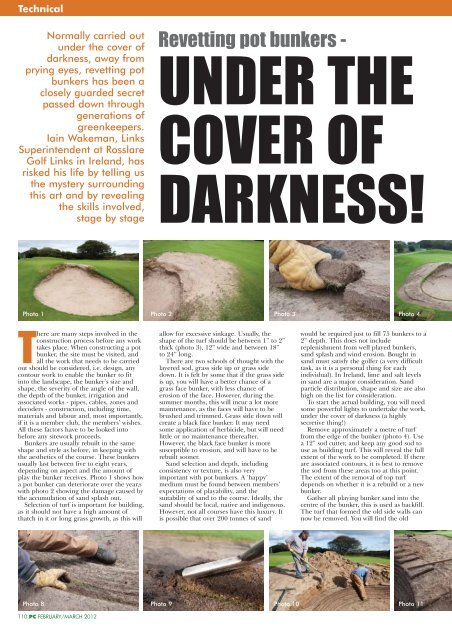these Open Championship Clubs choose to relief grind - Pitchcare
these Open Championship Clubs choose to relief grind - Pitchcare
these Open Championship Clubs choose to relief grind - Pitchcare
You also want an ePaper? Increase the reach of your titles
YUMPU automatically turns print PDFs into web optimized ePapers that Google loves.
Technical<br />
Normally carried out<br />
under the cover of<br />
darkness, away from<br />
prying eyes, revetting pot<br />
bunkers has been a<br />
closely guarded secret<br />
passed down through<br />
generations of<br />
greenkeepers.<br />
Iain Wakeman, Links<br />
Superintendent at Rosslare<br />
Golf Links in Ireland, has<br />
risked his life by telling us<br />
the mystery surrounding<br />
this art and by revealing<br />
the skills involved,<br />
stage by stage<br />
There are many steps involved in the<br />
construction process before any work<br />
takes place. When constructing a pot<br />
bunker, the site must be visited, and<br />
all the work that needs <strong>to</strong> be carried<br />
out should be considered, i.e. design, any<br />
con<strong>to</strong>ur work <strong>to</strong> enable the bunker <strong>to</strong> fit<br />
in<strong>to</strong> the landscape, the bunker’s size and<br />
shape, the severity of the angle of the wall,<br />
the depth of the bunker, irrigation and<br />
associated works - pipes, cables, zones and<br />
decoders - construction, including time,<br />
materials and labour and, most importantly,<br />
if it is a member club, the members’ wishes.<br />
All <strong>these</strong> fac<strong>to</strong>rs have <strong>to</strong> be looked in<strong>to</strong><br />
before any sitework proceeds.<br />
Bunkers are usually rebuilt in the same<br />
shape and style as before, in keeping with<br />
the aesthetics of the course. These bunkers<br />
usually last between five <strong>to</strong> eight years,<br />
depending on aspect and the amount of<br />
play the bunker receives. Pho<strong>to</strong> 1 shows how<br />
a pot bunker can deteriorate over the year,s<br />
with pho<strong>to</strong> 2 showing the damage caused by<br />
the accumulation of sand splash out.<br />
Selection of turf is important for building,<br />
as it should not have a high amount of<br />
thatch in it or long grass growth, as this will<br />
Revetting pot bunkers -<br />
UNDER THE<br />
COVER OF<br />
DARKNESS!<br />
Pho<strong>to</strong> 1 Pho<strong>to</strong> 2 Pho<strong>to</strong> 3 Pho<strong>to</strong> 4<br />
allow for excessive sinkage. Usually, the<br />
shape of the turf should be between 1” <strong>to</strong> 2”<br />
thick (pho<strong>to</strong> 3), 12” wide and between 18”<br />
<strong>to</strong> 24” long.<br />
There are two schools of thought with the<br />
layered sod, grass side up or grass side<br />
down. It is felt by some that if the grass side<br />
is up, you will have a better chance of a<br />
grass face bunker, with less chance of<br />
erosion of the face. However, during the<br />
summer months, this will incur a lot more<br />
maintenance, as the faces will have <strong>to</strong> be<br />
brushed and trimmed. Grass side down will<br />
create a black face bunker. It may need<br />
some application of herbicide, but will need<br />
little or no maintenance thereafter.<br />
However, the black face bunker is more<br />
susceptible <strong>to</strong> erosion, and will have <strong>to</strong> be<br />
rebuilt sooner.<br />
Sand selection and depth, including<br />
consistency or texture, is also very<br />
important with pot bunkers. A ‘happy’<br />
medium must be found between members’<br />
expectations of playability, and the<br />
suitability of sand <strong>to</strong> the course. Ideally, the<br />
sand should be local, native and indigenous.<br />
However, not all courses have this luxury. It<br />
is possible that over 200 <strong>to</strong>nnes of sand<br />
would be required just <strong>to</strong> fill 75 bunkers <strong>to</strong> a<br />
2” depth. This does not include<br />
replenishment from well played bunkers,<br />
sand splash and wind erosion. Bought in<br />
sand must satisfy the golfer (a very difficult<br />
task, as it is a personal thing for each<br />
individual). In Ireland, lime and salt levels<br />
in sand are a major consideration. Sand<br />
particle distribution, shape and size are also<br />
high on the list for consideration.<br />
To start the actual building, you will need<br />
some powerful lights <strong>to</strong> undertake the work,<br />
under the cover of darkness (a highly<br />
secretive thing!)<br />
Remove approximately a metre of turf<br />
from the edge of the bunker (pho<strong>to</strong> 4). Use<br />
a 12” sod cutter, and keep any good sod <strong>to</strong><br />
use as building turf. This will reveal the full<br />
extent of the work <strong>to</strong> be completed. If there<br />
are associated con<strong>to</strong>urs, it is best <strong>to</strong> remove<br />
the sod from <strong>these</strong> areas <strong>to</strong>o at this point.<br />
The extent of the removal of <strong>to</strong>p turf<br />
depends on whether it is a rebuild or a new<br />
bunker.<br />
Gather all playing bunker sand in<strong>to</strong> the<br />
centre of the bunker, this is used as backfill.<br />
The turf that formed the old side walls can<br />
now be removed. You will find the old<br />
Pho<strong>to</strong> 8 Pho<strong>to</strong> 9 Pho<strong>to</strong> 10 Pho<strong>to</strong> 11<br />
110 PC FEBRUARY/MARCH 2012

















